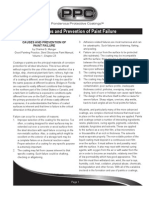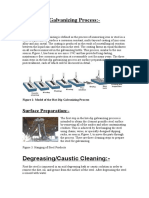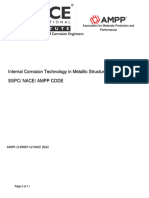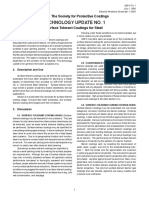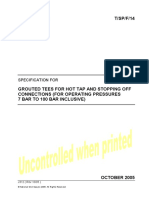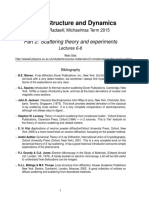Soluble Salts
Soluble Salts
Uploaded by
Ian NaylorCopyright:
Available Formats
Soluble Salts
Soluble Salts
Uploaded by
Ian NaylorCopyright
Available Formats
Share this document
Did you find this document useful?
Is this content inappropriate?
Copyright:
Available Formats
Soluble Salts
Soluble Salts
Uploaded by
Ian NaylorCopyright:
Available Formats
Inspection and Engineering
Soluble Salts
© Copyright 2016 Fitz-Coatings Ltd
Soluble Salts
Objective
The objective of this unit is to provide an understanding of how soluble salts affect protective coatings and how
to avoid coating failure.
Overview
The presence of water soluble salts on a steel surface can
significantly affect the performance of paint coatings depending on
the type of paint system, the service environment, the thickness of
the paint and the type and amount of the salts.
An aqueous environment is generally more aggresive where
soluble salts are concerned than an atmospheric environment with
pure water having a greater effect than salt water.
Types of Salt
Chlorides from the dissociaton of salts such as sodium chloride
are prevalent in marine environments from seawater and salt spray
and in inland locations from de-icing salts and chemical
processes.
Nitrates from the dissociation of salts such as ammonium nitrate
and sodium nitrate are found in fertilizers and oxides of nitrogen
can chemically react to produce nitrates
Sulphates are found from the combustion of coal and oil and can
form sulphuric acid.
Service Environment
Generally soluble salts have a more deleterious effect on paint
coating performance in an immersion situation where blistering is
the most common type of failure.
In an atmospheric environment under-film corrosion is more
common where the conditions are high humidity and intermittent
wetting.
Where long periods of exposure to condensation occur blistering
of the coating is often the predominating type of failure as time of
wetness and the type of water become important factors.
© Copyright 2016 Fitz-Coatings Ltd Page 1
Paint Systems
Paint systems vary in their tolerance to soluble salts.
Zinc silicate coatings can react with salts hence reducing their
effect.
Coatings containing laminar pigments and those which are
densely cross-linked are less permeable to moisture and hence
more resistant to blistering.
Generally the greater the coating thickness the greater is the
resistance to blistering and most coatings will have a tolerable salt
level, depending on the environment, below which there is a low
risk of failure by blistering.
The overall resistance of the coating to soluble salts will be
influenced by both generic type and formulation.
Permeability
As organic coatings are semi-permeable membranes, liquids can
diffuse through them.
The coatings will attain equilibrium with their environment by
absorbing or releasing water depending on the prevailing relative
humidity and the rate and degree to which this occurs will be
influenced by factors such as the generic type of coating and the
pigmentation where laminar pigments such as MIO provide more of
a barrier than normal pigments.
Although it has been shown that salts such as sodium chloride
can transport through paint coatings as their ions (Na+ and Cl-)
this ionic permeability is very much lower than that of water and
many films can be considered impermeable to dissolved solids.
Osmotic Blistering
Where water soluble salts are present at the coating/substrate
interface or between coats in a multicoat system and the coating
is in contact with an aqueous environment blistering can occur as
water absorbed by the coating is transported to the location of the
salts.
A concentration gradient will exist between the aqueous solution
at the site of the salts and the external aqueous environment in
contact with the coating surface.
© Copyright 2016 Fitz-Coatings Ltd Page 2
Osmotic Blistering
Existing coatings must be clear of soluble salts before being
overcoated with fresh coatings, especially in aqueous
environments.
Blistering will occur around the salt contaminants as illustrated.
The pressure pushes the coating out into a dome shape and the
size will depend on the amount of contaminants, coating type and
thickness and environments.
Osmotic Blistering
Because of this concentration gradient water will be drawn through
the film from the more dilute external solution to the site of the
soluble salts until the salt concentrations are equal.
If for example pure water is the external aqueous environment
more water will be transported through the film than if the external
environment was salt water.
Osmotic Blistering
As the process continues a pressure builds up at the site of the
salt due to the increase in volume and when it becomes high
enough to overcome the adhesion of the coating a blister will
develop.
Blister formation slows down with time as the salt concentration
decreases and the osmotic pressure becomes less.
The pressure that develops inside the blister due to the increased
water ingress can cause the blister to break.
Corrosion Within the Blister
Corrosion under a blister cap formed on a steel substrate will
occur and its rate will primarily depend on the degree of oxygen
permeation through the coating.
Ferrous ions initially formed will consume oxygen producing
soluble ferrous corrosion products which will be oxidised to the
ferric state and form a deposit , normally black in colour, on the
underside of the blister cap.
The access of oxygen to the internal of the blister will be hindered
by these deposits but access would be available at the periphery
of the blister and the cathodic sites will move outwards.
© Copyright 2016 Fitz-Coatings Ltd Page 3
Corrosion Within the Blister
The area of the blister can expand as corrosion products are
produced and underfilm corrosion occurs.
This is often characterised by black circular areas of corrosion on
the steel in way of the blister dome.
If the adhesion of the coating to the steel at the periphery of the
blister is such, as to resist the spread of underfilm corrosion, the
pressure created by a build up of corrosion product under the
blister cap can cause the blister to break allowing ingress of other
species and further corrosion.
Sampling
Before analysis for soluble salts can be undertaken they have to
be extracted from the surface in an aqueous solution.
The method described in ISO 8502-6, “The Bresle method” utilises
an adhesive patch designed to hold the extraction liquid in a
central compartment.
The self adhesive patch is attached to the surface and the
extraction liquid injected into the compartment with a syringe.
The liquid is sucked back into the syringe and re-injected with the
process being repeated a number of times before the liquid, now
containing the soluble salts is transferred to a container for
analysis.
Qualitative Tests
These test indicate whether a contaminant is present but not the
exact amount.
Potassium ferricyanide is used to detect the presence of ferrous
ions.
In the test a fine mist of water is sprayed onto a small area of the
blast cleaned surface and allowed to evaporate.
The test paper previously soaked in the potassium ferricyanide
solution and allowed to dry is pressed onto the surface for 2 to 5
seconds.
Any soluble salts present will react with the ferricyanide to
produce a prussian blue complex appearing as blue dots on the
test paper.
© Copyright 2016 Fitz-Coatings Ltd Page 4
Qualitative Tests
If a few drops of silver nitrate solution are placed on an area of the
blast cleaned surface chlorides will show as white spots which are
precipitated silver chloride. It should be noted that this test is not
as sensitive as other methods.
Merckoquant test strips are available to determine semi-
quantitatively many ions including chloride, iron, nitrate and
sulphate.
The strip is dipped into the extracted liquid, the excess water
shaken off and the colour produced compared with the scale
provided.
Different test strips are used for different ions and the deeper the
colour the higher the concentration.
Quantitative Tests
ISO 8502-2 Laboratory determination of chloride on cleaned
surface.
The extraction liquid from the Bresle patch can be used or a
known area swabbed with an absorbent cotton pad soaked in
water and the washings squeezed into beaker and filtered prior to
making up to 50ml in a volumetric flask.
20ml of the liquid is placed in a conical flask, 5 drops of
diphenylcarbazone/bromophenol blue indicator added, acidified
with nitric acid if necessary until the colour is yellow, and titrated
with a standard volumetric solution of mercury (11) nitrate solution
until the colour changes to a blue-violet.
From the volume of titrant required the amount of chloride per unit
area can be calculated.
Quantitative Tests
ISO 8502-5 Measurement of chloride by the ion detection tube
method.
The extraction liquid from the Bresle patch can be used or a
known area swabbed with an absorbent cotton pad soaked in
water as described in the standard.
The method employs glass detection tubes containing silver
chromate in a silica carrier which undergoes a change in colour on
reaction with chloride ions.
Both ends of the tube are cut off and one end immersed vertically
in the extraction liquid. The liquid rises up the tube and the
chloride concentration can be read off the scale engraved on the
tube at the highest point where a slight colour change has
occurred.
The amount of chloride per unit area can be calculated from the
tube reading, the sampled area and the extract volume.
Quantitative Tests
ISO 8502-9 Field method for the conductometric determination of
© Copyright 2016 Fitz-Coatings Ltd Page 5
water soluble salts.
The salts are removed from the surface by the Bresle patch
method using water as the solvent.
The electrodes of a conductivity meter are immersed in the liquid
and the conductivity expressed as micro Siemens per centimetre
(µS/cm) recorded.
A simplified formula is provided in the standard to calculate the
surface density of the salts.
N.B. The method measures total ionic contaminants and does not
determine the individual surface densities of for example chlorides
and sulphates.
Quantitative Tests
ISO 8502-10 Field method for the titrimetric determination of water
soluble chloride.
The extraction liquid from the Bresle patch can be used or any
other convenient method.
The reactants are in four solutions:
Solution A - diphenylcarbazone/bromophenol blue indicator
Solution B – 0.5 mol/L Nitric acid
Solutions C and D – Mercuric nitrate titrant (the C and D solutions
are of different concentration to cater for high and low chloride
concentrations)
The extract solution is placed in a beaker and 2 drops of solution
A are added followed by drops of solution B until it turns yellow.
Drops of solution C or D are added slowly until the solution colour
changes to blue.
From the number of drops used the surface density of chloride can
be calculated.
Quantitative Tests
ISO 8502-11 Field method for the turbidimetric determination of
water soluble sulphate.
The extraction liquid from the Bresle patch can be used or from
any other convenient method.
The precipitant, usually a solution of barium chloride, and a
flocculant are added to the extraction liquid. If sulphate is present
it is precipitated as colloidal barium sulphate.
A turbidimeter is used to measure the spectral absorbance of the
dispersion which is related to the sulphate content.
From the results the surface density of the sulphate can be
calculated.
© Copyright 2016 Fitz-Coatings Ltd Page 6
Quantitative Tests
ISO 8502-12 Field method for the titrimetric determination of water
soluble ferrous ions.
The extraction liquid from the Bresle patch can be used or any
other convenient method.
The extracted liquid is placed in a plastic beaker, 1 ml of
diphenylamine sulphonate indicator solution added, followed by 4
ml of phosphoric acid solution and titrated dropwise with a
standard volumetric solution of potassium dichromate until the
colour changes through a greyish blue to violet.
From the number of drops of titrant required the amount of chloride
per unit area can be calculated.
Quantitative Tests
Instrumental method for total salt concentration by conductivity
(Limpet cell).
A number of instruments are available and all operate on the same
general principal.
The cell containing an electric stirrer is attached to the steel
surface by inbuilt magnets in the base and seals against the
surface with a rubber gasket.
Water is injected into the cell, the stirrer switched on for a set
period of time and after switching off the conductivity can be read
from the attached digital display expressed in micro Siemens per
centimetre (µS/cm) .
Depending on the instrument the surface density of the salts can
be automatically displayed. The results may also be able to be
displayed as equivalent chloride or sodium chloride where all of the
salts are assumed to be from sodium chloride.
N.B. The method measures total ionic contaminants and does not
determine the individual surface densities of for example chlorides
and sulphates.
SSPC Technology Guide 15
Field Methods for the Retrieval and Analysis of Soluble Salts
on Steel and Other Nonporous Surfaces (1)
This guide includes the parts of ISO 8502 referenced earlier and
additionally describes other methods of retrieval and analysis of
soluble salts both in the field and the laboratory.
The following slides provide an outline of these additional methods.
© Copyright 2016 Fitz-Coatings Ltd Page 7
SSPC Technology Guide 15
Field Methods for the Retrieval and Analysis of Soluble Salts
on Steel and Other Nonporous Surfaces (2)
Retrieval methods
Three classes are listed:
Class A – Involves the extraction liquid being held in contact with
the surface using a latex patch cell (A1) or sleeve (sock) (A2). The
liquid can be massaged through the film to aid dissolution of the
salts.
Class B – Involves a methodology for keeping a known volume of
liquid within a measured area of the surface. B1 - Swabbing or
washing with cotton swabs and deionized water.
B2 – Extraction of the salts by placing a pre-wetted filter paper on
the surface.
Class C – Involves immersing the entire surface in boiling water
and hence is only applicable for use in the laboratory. The method
uses a predetermined volume of extraction liquid and a known
surface area.
SSPC Technology Guide 15
Field Methods for the Retrieval and Analysis of Soluble Salts
on Steel and Other Nonporous Surfaces (3)
Extract solution
All retrieval methods use deionized or distilled water (reagent
water) with a maximum conductivity of 5µS/cm or a proprietary
solution.
Proprietary solutions may be supplied with commercial extraction
kits and should only be used for the soluble salts described in the
kit instructions. They are not normally suitable for measuring the
conductivity of extracted solutions.
Each of the retrieval methods is described in detail in the guide
and the student should read that section of the guide carefully.
SSPC Technology Guide 15:
Field Methods for the Retrieval and Analysis of Soluble Salts
on Steel and Other Nonporous Surfaces (4)
Analytical methods
Methods are described for the quantitative analysis of the
following:-
Conductivity – This is a measure of the total dissolved salts and
procedures for two types of meters are described. The “pocket”
meter which operates by placing the probes into the liquid to be
analysed and the “cup-type” where the liquid is place in a cup that
forms part of the meter. A special meter for analysing the filter
paper extract from extraction method B2 is also described.
© Copyright 2016 Fitz-Coatings Ltd Page 8
SSPC Technology Guide 15
Field Methods for the Retrieval and Analysis of Soluble Salts
on Steel and Other Nonporous Surfaces (5)
Analytical methods
Soluble chloride ion – Four methods are described:-
a) An ion detection tube as described in ISO 8502-5 which can
detect chloride levels in the range 1 to 2,000 ppm.
b) A paper strip method which can detect chloride levels in the
range 30 to 600+ ppm.
c) A titration method based upon ISO 8502-10 (withdrawn)
d) A laboratory reference titration method based on ISO 8502-2
SSPC Technology Guide 15
Field Methods for the Retrieval and Analysis of Soluble Salts
on Steel and Other Nonporous Surfaces (6)
Analytical methods
Soluble ferrous ion – A quantitative and a qualitative method are
described.
Quantitative – In this method a test strip that forms a red
colour in the presence of ferrous ions by reaction with 1,10
phenanthroline is moistened with the extraction liquid. The
intensity of colour provides an indication of ferrous ion
concentration as low as 0.5 ppm.
Qualitative – A blotting paper treated with potassium
ferricyanide solution is moistened and pressed onto the
surface. Ferrous ions are indicated as blue spots on the
blotting paper. Sensitivity is less than 1 ppm.
SSPC Technology Guide 15
Field Methods for the Retrieval and Analysis of Soluble Salts
on Steel and Other Nonporous Surfaces (7)
Analytical methods
Soluble sulphate ion – A visual and an instrumental method are
described. Both methods work on the principle that the addition of
a solution of barium chloride to the extraction liquid will become
turbid (turn cloudy) if sulphate ions are present.
Visual method – This involves the comparison of the
cloudiness produced in the test liquid with panes of plastic
with different degrees of cloudiness equivalent to different
sulphate concentrations under the test conditions. The
minimum level of sulphate concentration is approximately 20
ppm.
Instrumental – The instrument measures the turbidity of the
solution after barium chloride has been added over the range 1
to 200 ppm.
© Copyright 2016 Fitz-Coatings Ltd Page 9
SSPC Technology Guide 15
Field Methods for the Retrieval and Analysis of Soluble Salts
on Steel and Other Nonporous Surfaces (8)
Analytical methods
Soluble nitrate ion – The method involves the use of a paper strip
that changes colour when dipped into a solution containing nitrate
ions. The colour depth is compared to a scale which indicates the
concentration in a detection range up to 50 ppm.
Appendices describe in detail the boiling extraction method, the
determination of surface concentration from solution concentration,
and the determination of equivalent concentration from conductivity
(chloride and total salt).
SSPC Technology Guide 15
Field Methods for the Retrieval and Analysis of Soluble Salts
on Steel and Other Nonporous Surfaces (9)
Extraction Efficiency
This is defined as the quantity of soluble salt that can be retrieved
from the surface as a percentage of the total amount present.
The extraction efficiency is affected by a number of factors
including:-
1. Method of extraction
2. Proficiency of the operator
3. Degree of surface roughness
4. Size of the extraction area
5. Type and concentration of the soluble salts
6. Degree of corrosion and pitting of the substrate
7. Extraction time
8. Method of contamination (natural or artificial)
SaltSmart
A hand held, automated method for determination of soluble salts
by conductivity measurement on flat and curved surfaces as an
alternative method to the Bresle patch (ISO 8502-9)
It is comprised of a one-time-use disposable sensor, and a special
meter to obtain readings.
PROCESS STEPS
1. Place the included ampoule containing pre-measured de-ionized
water onto the SaltSmart ™ device.
Use a strip of painters tape or other suitable no-residue tape
to hold the sensor onto the surface under test.
Wait approximately 8 minutes, then take the device off the
surface and place into the SaltSmart ™ meter, and read the
value on the backlit display
The SaltSmart ™ meter records the date, time and surface
salt concentration (up to 255 readings) for easy download
through USB connection.
© Copyright 2016 Fitz-Coatings Ltd Page 10
SSM
A hand held, automated method for determination of soluble salts
by conductivity measurement on flat and curved surfaces as an
alternative method to the Bresle patch (ISO 8502-9)
PROCESS STEPS
1. Attach meter to surface
2. Inject deionized water into SSM with one press of the dose
bottle
3. Press “Start”: SSM automatically agitates solution, takes
measurement, displays the result on LCD screen and stores
data in memory.
4. Remove SSM and wipe remaining water from surface.
5. Clean meter by flushing SSM with deionized water.
All data is stored electronically and can be downloaded to any PC
spreadsheet programme Electronic data can be exchanged into a
Coating Technical File (CTF).
Summary
Within this training unit we have discussed the different types of
soluble salts and how these salts affect a coatings performance.
We discussed permeability of coating systems and osmotic
blistering of a coating applied over a surface with soluble salts
present.
We also discussed the various methods of testing for soluble salts
including the sampling and analysis which includes ISO Standards
and SSPC guides.
© Copyright 2016 Fitz-Coatings Ltd Page 11
You might also like
- Chapt 05Document25 pagesChapt 05Jesse McClure100% (9)
- BGAS - Question & AnswerDocument27 pagesBGAS - Question & Answerthanhdk007100% (1)
- Icorr BookDocument984 pagesIcorr BookSuraj M Sethu100% (1)
- TSPP8Document76 pagesTSPP8Ian Naylor100% (1)
- TSPP9Document90 pagesTSPP9Ian NaylorNo ratings yet
- Biogeography BookDocument72 pagesBiogeography BookAnkit Anand0% (1)
- The Basics of Airless SprayingDocument56 pagesThe Basics of Airless SprayingKalaiyazhagan ElangeeranNo ratings yet
- Corrodere Brochure 12ppDocument12 pagesCorrodere Brochure 12ppJoventino AlvesNo ratings yet
- Q10Document21 pagesQ10Ian Naylor100% (1)
- Salt TestDocument16 pagesSalt Testم.ذكى فضل ذكى100% (1)
- Coating Failure DefectsDocument46 pagesCoating Failure DefectsKamal Fahmi100% (3)
- TP913 Coating Thickness CheckDocument5 pagesTP913 Coating Thickness CheckShahril ZainulNo ratings yet
- Chlor Rid SlidesDocument47 pagesChlor Rid Slidesmohammed goudaNo ratings yet
- Coating DefectsDocument13 pagesCoating DefectswahNo ratings yet
- Challenges With Using Ethyl Silicate Inorganic Zinc-Rich PrimerDocument43 pagesChallenges With Using Ethyl Silicate Inorganic Zinc-Rich PrimerMOHAMEDNo ratings yet
- 01 Corrosion Grade1Document23 pages01 Corrosion Grade1Harry DobleNo ratings yet
- Tips Calculation-JotunDocument17 pagesTips Calculation-JotunRodrigoMorenoNo ratings yet
- Jotun DeveloperDocument7 pagesJotun DeveloperAlex Kuvoric100% (1)
- Painting DefectsDocument70 pagesPainting Defectsahmed sobhy100% (2)
- Painting FailureDocument21 pagesPainting FailureNnamdi Celestine NnamdiNo ratings yet
- Index of Coating DefectsDocument41 pagesIndex of Coating DefectsMathan76100% (1)
- Long Question/ Narrative Question.: Define Pigment?Document3 pagesLong Question/ Narrative Question.: Define Pigment?Hau LeNo ratings yet
- Coating Failures - Causes, Identification, and AnalysisDocument36 pagesCoating Failures - Causes, Identification, and AnalysisSUBODH100% (1)
- G16S-0205-01 - Repair Hot Drip Galv SurfaceDocument5 pagesG16S-0205-01 - Repair Hot Drip Galv Surfacepuwarin naja100% (1)
- Protecting Steel Edges: Presented By: Bob Kogler, Rampart LLCDocument42 pagesProtecting Steel Edges: Presented By: Bob Kogler, Rampart LLCSuperCow FelizNo ratings yet
- Paint Technology Diploma Course AssignmentDocument11 pagesPaint Technology Diploma Course AssignmentAnonymous UdYX3b100% (1)
- Inspect Flash RustDocument113 pagesInspect Flash RustMario Jorge Pereira100% (1)
- Painting Inspection Grade 2/3 Exam: Unit Test - 4Document1 pagePainting Inspection Grade 2/3 Exam: Unit Test - 4AjeetKumar0% (1)
- Trouble With Paint Blistering of Paint On Metal 1Document10 pagesTrouble With Paint Blistering of Paint On Metal 1ravi00098No ratings yet
- Lesson 2 - Duties of A Painting (Coatings) InspectorDocument55 pagesLesson 2 - Duties of A Painting (Coatings) InspectorFarhad AsadulovNo ratings yet
- Coating Painting QUSTIONDocument17 pagesCoating Painting QUSTIONRajesh Kumar Ravi100% (1)
- Standard Coating For BWTDocument49 pagesStandard Coating For BWTSonny Sonjaya100% (3)
- 1.2.4 HDG - Painting Issues PDFDocument2 pages1.2.4 HDG - Painting Issues PDFAnonymous 1AAjd0No ratings yet
- Losses in PaintDocument5 pagesLosses in PaintVishrantGandhiNo ratings yet
- Pull Off Adhesion Testing of CoatingsDocument12 pagesPull Off Adhesion Testing of CoatingsDANIEL MOYYA100% (2)
- Pipeline Coatings The Petrobrás Experience: Joaquim P. Quintela Jorge TavesDocument51 pagesPipeline Coatings The Petrobrás Experience: Joaquim P. Quintela Jorge Tavesnathgsurendra100% (2)
- NACE CIP Part II - (8) Health - Safety - (Qs - As)Document6 pagesNACE CIP Part II - (8) Health - Safety - (Qs - As)MIREYA RUBI SARAO ORUETANo ratings yet
- Marine Coating Failure AnalysisDocument35 pagesMarine Coating Failure Analysisa7med_nassar171100% (3)
- Application Notes Spray CoatingsDocument6 pagesApplication Notes Spray CoatingsIqbalAbdulloh100% (1)
- MS - Dolly Test ProcedureDocument4 pagesMS - Dolly Test ProcedureRahul Moottolikandy100% (1)
- Aga CourseDocument40 pagesAga CourseTarek YehiaNo ratings yet
- Frosio Insulation NotesDocument41 pagesFrosio Insulation NotesJANVI KRISHNo ratings yet
- Technical-service-Role-of-Coating-Advisor 2010 - tcm189-80199 PDFDocument14 pagesTechnical-service-Role-of-Coating-Advisor 2010 - tcm189-80199 PDFBADIUZZAMA AZMI100% (1)
- 5.dry Abrasive BlastingDocument15 pages5.dry Abrasive BlastingDanica SekulicNo ratings yet
- Organic Coatings - Composition and FilmDocument24 pagesOrganic Coatings - Composition and Filmkevin100% (1)
- Ampp Nace Code Estructural CoatingDocument12 pagesAmpp Nace Code Estructural CoatingJavier Enrique Diaz ChacinNo ratings yet
- Galvanized Rebar Vs Epoxy RebarDocument4 pagesGalvanized Rebar Vs Epoxy RebarvintagerulzNo ratings yet
- Flash Rust Formed After WaterjettingDocument12 pagesFlash Rust Formed After WaterjettingPedro Michell Rodriguez PerezNo ratings yet
- FROSIO - Flash QuesDocument4 pagesFROSIO - Flash QuesAnte BosancicNo ratings yet
- SSPC Tu 1Document3 pagesSSPC Tu 1Prashant PandeyNo ratings yet
- PAINT Coating Damage and DefectsDocument70 pagesPAINT Coating Damage and DefectsAntony Tomais100% (1)
- Paint Inspection Limited Surface Preparation StandardsDocument19 pagesPaint Inspection Limited Surface Preparation StandardsAndrew PattersonNo ratings yet
- Revision Questions AnswerDocument37 pagesRevision Questions AnswerahmedNo ratings yet
- Imo-Pspc - Abg (54K Bulk Carrier) - 2Document112 pagesImo-Pspc - Abg (54K Bulk Carrier) - 2Tanmay Gor100% (1)
- The Importance of Certified Coating Inspector For IMO PSPC RulesDocument21 pagesThe Importance of Certified Coating Inspector For IMO PSPC Rulesigeorge7950% (2)
- Apcs 113 - Inorganic ZincDocument11 pagesApcs 113 - Inorganic ZincMoghal AliNo ratings yet
- Frosio BookDocument225 pagesFrosio BookShoba Raj100% (1)
- Touch Up and Repair of Galvanized SteelDocument5 pagesTouch Up and Repair of Galvanized SteelkhuzafaNo ratings yet
- CIP Session I Quiz-4Document5 pagesCIP Session I Quiz-4munna100% (6)
- Theoretical and Practical CoverageDocument4 pagesTheoretical and Practical CoverageSherif AbdelhameedNo ratings yet
- Inspections/full Package, Frosio-Nace Certified InspectorsDocument8 pagesInspections/full Package, Frosio-Nace Certified InspectorsZiom Ziomek100% (1)
- AnswersDocument4 pagesAnswersWaseem YounisNo ratings yet
- Challenges in Corrosion: Costs, Causes, Consequences, and ControlFrom EverandChallenges in Corrosion: Costs, Causes, Consequences, and ControlNo ratings yet
- Trouble With Paint - Blistering of Paint On MetalDocument10 pagesTrouble With Paint - Blistering of Paint On Metaligeorge79100% (1)
- Corrosion: Corrosive Condition Description of EnvironmentDocument7 pagesCorrosion: Corrosive Condition Description of EnvironmentMaddyNo ratings yet
- T SP F 14 2005Document35 pagesT SP F 14 2005Ian NaylorNo ratings yet
- Afa HBSDD 0013 01 Aa enDocument117 pagesAfa HBSDD 0013 01 Aa enVictor CastrejonNo ratings yet
- Engineering Structures: Farid Bouziadi, Bensaid Boulekbache, Abdelkader Haddi, Mostefa Hamrat, Cha Fika DjelalDocument10 pagesEngineering Structures: Farid Bouziadi, Bensaid Boulekbache, Abdelkader Haddi, Mostefa Hamrat, Cha Fika DjelalEmad RabadiNo ratings yet
- Storage Abe421Document63 pagesStorage Abe421AJ mnNo ratings yet
- Shapta Uce Chemistry P1 2024 4Document5 pagesShapta Uce Chemistry P1 2024 4Rehemah NalugoNo ratings yet
- Fabrication ProcedureDocument17 pagesFabrication Procedureanang Wahjudi100% (2)
- Jta LTT2Document5 pagesJta LTT2AnathemaNo ratings yet
- Crystalstructure Handouts Part2 PDF 87909Document46 pagesCrystalstructure Handouts Part2 PDF 87909mustafa alasadyNo ratings yet
- Hydrotreating: Aqeel Ahmad TAIMOORDocument20 pagesHydrotreating: Aqeel Ahmad TAIMOORqaiser manzilNo ratings yet
- Fibre To Fabric Q BankDocument4 pagesFibre To Fabric Q BankRiju George100% (1)
- Physics Investigatory Project LIGHT DEPEDocument15 pagesPhysics Investigatory Project LIGHT DEPEJerin JacobNo ratings yet
- 2379 - 1990 Colour CodingDocument13 pages2379 - 1990 Colour Codingjitesh26No ratings yet
- Improvements in Superabsorbent Water Blocking Materials For New Power Cable ApplicationsDocument6 pagesImprovements in Superabsorbent Water Blocking Materials For New Power Cable Applicationsssingaram1965No ratings yet
- 84 FullDocument8 pages84 FullcutefrenzyNo ratings yet
- Lecture 2 - Atomic Structure and BondingDocument29 pagesLecture 2 - Atomic Structure and BondingMercylin MakambureNo ratings yet
- LJ Parameters For Propane PropeneDocument5 pagesLJ Parameters For Propane Propenesridhar pallaNo ratings yet
- Non Metallic MaterialsDocument16 pagesNon Metallic Materialsthisisjinesh100% (1)
- Preparation 4 Chocolate Base Calcium Lonzenges PDFDocument15 pagesPreparation 4 Chocolate Base Calcium Lonzenges PDFmadiana.salvidarNo ratings yet
- Acite Acivity 3-104Document28 pagesAcite Acivity 3-104Sehaj Srk100% (1)
- SP Guide To CompositesDocument69 pagesSP Guide To CompositesCefirel_grifonNo ratings yet
- Positive Material Identification Procedure: IndexDocument8 pagesPositive Material Identification Procedure: Indexrame63No ratings yet
- Study of 6T SRAM Cell Using High-K Gate Dielectric Based Junctionless Silicon Nanotube FETDocument8 pagesStudy of 6T SRAM Cell Using High-K Gate Dielectric Based Junctionless Silicon Nanotube FETRaj sambhavNo ratings yet
- Ficha Tecnica Cp670Document13 pagesFicha Tecnica Cp670Alexander Kurenay SamNo ratings yet
- Product Manual Coway Kecil CHP-6200NDocument32 pagesProduct Manual Coway Kecil CHP-6200NNiraaj Chandran NairNo ratings yet
- Direct Operated Pressure Temp Regulating ValvesDocument22 pagesDirect Operated Pressure Temp Regulating ValvesSergio eulises Orellana cruzNo ratings yet
- Ionic Compounds ProjectDocument2 pagesIonic Compounds Projectapi-533864204No ratings yet
- Castrol Molub-Alloy 936 SF HeavyDocument2 pagesCastrol Molub-Alloy 936 SF HeavyhanafiajaNo ratings yet
- Company and PVCU Pipe IntroductionDocument20 pagesCompany and PVCU Pipe IntroductionSina KakarottoNo ratings yet
- Bearing StressDocument5 pagesBearing StressKristopher Archie PlaquiaNo ratings yet



















